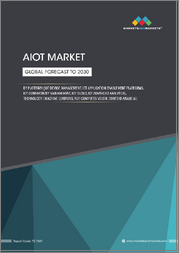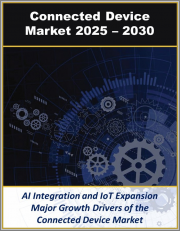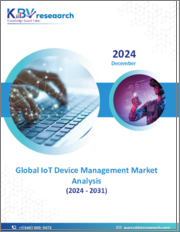
|
시장보고서
상품코드
1588687
IoT 디바이스 관리 시장 규모, 점유율, 동향 분석 보고서 : 구성요소별, 전개 방식별, 기업 규모별, 최종 용도별, 지역별, 부문별 예측(2025-2030년)IoT Device Management Market Size, Share & Trends Analysis Report By Component (Solution, Services), By Deployment Mode, By Enterprise Size, By End Use, By Region, And Segment Forecasts, 2025 - 2030 |
||||||
IoT 디바이스 관리 시장 성장 및 동향:
Grand View Research, Inc.의 최신 보고서에 따르면, 세계 IoT 디바이스 관리 시장 규모는 2030년까지 259억 3,000만 달러에 달할 것으로 예상되며, 2025년부터 2030년까지 연평균 36.5%의 CAGR을 기록할 것으로 예상됩니다.
이 산업은 수직적 디지털 혁명과 최종 사용 산업 전반에 걸친 IoT 기기 도입 확대 등의 요인으로 인해 크게 성장하고 있습니다. 기업의 디지털 혁신에 대한 관심이 높아짐에 따라 프로세스 산업 전반에 걸쳐 스마트폰과 인터넷 서비스의 채택이 증가하면서 산업 성장을 크게 촉진하고 있습니다. 또한, 센서 판매 가격의 하락과 비즈니스 프로세스의 표준화 발전은 예측 기간 동안 시장을 견인할 것으로 예상됩니다.
또한, 공급망 전반에 걸쳐 산업 장비 및 상업용 제품의 관리, 모니터링, 계획 및 유지보수를 위해 IoT 기술이 채택되고 있는 것도 시장 성장을 촉진할 것으로 보입니다. 여러 기업들이 제품 개발을 강화하기 위해 IoT 기술을 도입함에 따라 원격 설정, 자동 장치 감지, 자동 온보딩과 같은 기능과 함께 효율적인 IoT 디바이스 관리 솔루션에 대한 수요가 증가하고 있다, 다양한 센서와 게이트웨이, 여러 인터넷 프로토콜을 관리할 수 있도록 도와줍니다. 예를 들어, 가전제품 제조업체인 월풀(Whirlpool Corp.)은 2022년 3월 PTC와 파트너십을 맺고 공장 혁신을 통해 제품 및 브랜드 라이프사이클 전반에 걸쳐 제품 개발의 효율성을 높였습니다.
Whirlpool Corp.은 PTC의 PLM 솔루션인 Windchill을 BOM 변환(EBOM, MBOM, SBOM), BOM 관리, 테스트, 요구사항 관리 및 검증을 위한 중앙 집중식 데이터 소스로 활용하고 있습니다. 또한, Whirlpool Corp.은 증강현실(AR), 데이터 기반 설계, 디지털 트윈과 같은 다른 기술을 시도하여 제품 수명주기 관리(PLM)를 기업 전체로 확장하고 있습니다. 이에 따라 자동차, 제조업, 금속 및 광업과 같은 자산 집약적 산업에서 IoT 디바이스 관리에 대한 수요가 크게 증가했습니다. 또한, 자산의 다운타임을 예측하고 과도한 유지보수 비용을 줄이기 위한 IoT 활용이 증가함에 따라 전 세계적으로 IoT 디바이스 관리의 채택이 꾸준히 증가하고 있습니다.
예를 들어, 2022년 10월 스톡홀름에 본사를 둔 엣지 AI 플랫폼 제공업체인 Imagimob AB는 AI 칩 솔루션 제공업체인 Syntiant와 협력하여 Imagimob AB의 tinyML 플랫폼과 Syntiant의 저전력 프로세서 NDP120을 통합했습니다. Imagimob AB의 플랫폼을 통해 개발자들은 상용 머신러닝(ML) 애플리케이션을 출시하고 배터리 제약이 있는 IoT 애플리케이션에 적합한 NDP120 프로세서에서 모델을 빠르게 구축할 수 있습니다. Imagimob AB 플랫폼은 키워드 감지, 낙상 감지, 이벤트 감지, 제스처 감지, 이상 감지 등 다양한 애플리케이션을 지원하며, Imagimob AB 플랫폼에는 낙상 감지, 메타데이터(비디오), 사전 훈련된 ML 모델, H5 형식의 주석이 달린 데이터 세트를 포함하며, IMU 데이터를 사용하여 벨트에 장착된 장치에서 넘어짐을 감지합니다.
Imagimob AB의 AI 개발 플랫폼을 사용하면 몇 분 안에 데이터 수집 및 엣지 디바이스에 배포할 수 있으며, Imagimob AB의 AI 플랫폼은 제스처 인식, 음성 모니터링 센서, 예지보전, 자재 감지, 사람의 움직임 등 다양한 IoT 제품에 사용되고 있습니다. 커넥티드 디바이스를 관리하고 디바이스의 역량을 최대한 활용하여 최적의 성능을 달성하기 위한 중앙 집중식 디바이스에 대한 수요가 증가함에 따라 예측 기간 동안 시장 성장을 촉진할 것으로 예상됩니다. 또한, 산업별 팬데믹으로 인해 의료 시설에서 IoT 기술의 이점에 대한 인식이 높아지면서 예측 기간 동안 헬스케어 분야 전반에 걸쳐 IoT 디바이스 관리의 채택이 증가할 것으로 예상됩니다.
IoT 디바이스 관리 시장 보고서 하이라이트
- 서비스 부문은 지원 및 유지보수 서비스에 대한 수요 증가와 IoT 기기 보급 증가로 인해 예측 기간 동안 견인력을 높일 것으로 예상됩니다.
- 또한 서비스 부문은 비즈니스 IoT 솔루션이 애자일 기법을 사용하여 배포되어 최종사용자에게 개인화된 경험을 제공할 수 있도록 보장합니다.
- 매니지드 서비스 부문은 클라우드 기반 매니지드 서비스에 대한 수요 증가와 비즈니스 생산성 향상을 위한 조직의 IT 자산에 대한 의존도가 높아지면서 2025년부터 2030년까지 가장 높은 CAGR을 기록할 것으로 예측됩니다.
- 보안 솔루션 분야는 예측 기간 동안 가장 빠른 성장률을 기록할 것으로 예상됩니다. 데이터, 커넥티드 디바이스, 커넥티드 자산 보호에 대한 요구가 증가하면서 이 분야를 견인할 것으로 보입니다.
- 또한, 다양한 디바이스의 연결, 표준화, 호환성으로 인해 보안 솔루션에 대한 요구도 증가하고 있습니다.
- 중소기업 부문은 2025년부터 2030년까지 가장 높은 CAGR을 기록할 것으로 예상됩니다. 디지털화를 도입하기 위해 중소기업에 자본을 제공하는 정부 당국의 역할이 증가함에 따라 이 부문의 성장이 촉진될 것으로 예상됩니다.
- 또한 IoT와 분석 툴을 통합함으로써 중소기업은 이전과는 다른 방식으로 고객 데이터에 접근할 수 있게 되고, 민첩성을 높여 시장 수요에 빠르게 대응할 수 있게 되어 시장 성장을 촉진할 수 있습니다.
- 아시아태평양은 정부가 지능형 디바이스를 광범위하게 도입한 중소기업 육성에 집중하고 있어 예측 기간 동안 가장 높은 CAGR을 기록할 것으로 예상됩니다. 또한, 이 지역의 중소기업 부문은 비용 효율적인 하드웨어 및 소프트웨어에 대한 풍부한 현지 접근성, 5G 기술 구현, 폐기되는 레거시 기술의 감소로 인해 크게 성장하고 있습니다.
목차
제1장 조사 방법과 범위
제2장 주요 요약
제3장 IoT 디바이스 관리 변수, 동향, 범위
- 시장 소개/계통 전망
- 업계 밸류체인 분석
- 시장 역학
- 시장 성장 촉진요인 분석
- 시장 성장 억제요인 분석
- 업계 기회
- IoT 디바이스 관리 분석 툴
- Porters 분석
- PESTEL 분석
제4장 IoT 디바이스 관리 시장 : 컴포넌트 추정·동향 분석
- 부문 대시보드
- IoT 디바이스 관리 : 구성요소 변동 분석, 2024년 및 2030년
- 솔루션
- 서비스
제5장 IoT 디바이스 관리 시장 : 솔루션 추정·동향 분석
- 부문 대시보드
- IoT 디바이스 관리 : 솔루션 변동 분석, 2024년 및 2030년
- 실시간 스트리밍 분석
- 보안 솔루션
- 데이터 관리
- 원격 모니터링
- 네트워크 대역폭 관리
제6장 IoT 디바이스 관리 시장 : 서비스 추정·동향 분석
- 부문 대시보드
- IoT 디바이스 관리 : 서비스 변동 분석, 2024년 및 2030년
- 프로
- 관리
제7장 IoT 디바이스 관리 시장 : 전개 방식 추정·동향 분석
- 부문 대시보드
- IoT 디바이스 관리 : 전개 방식 변동 분석, 2024년 및 2030년
- 퍼블릭 클라우드
- 프라이빗 클라우드
- 하이브리드 클라우드
제8장 IoT 디바이스 관리 시장 : 기업 규모 추정·동향 분석
- 부문 대시보드
- IoT 디바이스 관리 : 기업 규모 변동 분석, 2024년 및 2030년
- 대기업
- 중소기업
제9장 IoT 디바이스 관리 시장 : 최종 용도 추정·동향 분석
- 부문 대시보드
- IoT 디바이스 관리 : 최종 용도 변동 분석, 2024년 및 2030년
- 소매
- 헬스케어
- 운송·물류
- 유틸리티
- 제조업
- 기타
제10장 IoT 디바이스 관리 시장 : 지역 추정·동향 분석
- IoT 디바이스 관리 점유율, 지역별, 2024년 및 2030년
- 북미
- 구성요소별, 2018-2030년
- 솔루션별, 2018-2030년
- 서비스별, 2018-2030년
- 전개 방식별, 2018-2030년
- 기업 규모별, 2018-2030년
- 업계별, 2018-2030년
- 미국
- 캐나다
- 멕시코
- 유럽
- 구성요소별, 2018-2030년
- 솔루션별, 2018-2030년
- 서비스별, 2018-2030년
- 전개 방식별, 2018-2030년
- 기업 규모별, 2018-2030년
- 업계별, 2018-2030년
- 영국
- 독일
- 프랑스
- 아시아태평양
- 구성요소별, 2018-2030년
- 솔루션별, 2018-2030년
- 서비스별, 2018-2030년
- 전개 방식별, 2018-2030년
- 기업 규모별, 2018-2030년
- 업계별, 2018-2030년
- 중국
- 인도
- 일본
- 호주
- 한국
- 라틴아메리카
- 구성요소별, 2018-2030년
- 솔루션별, 2018-2030년
- 서비스별, 2018-2030년
- 전개 방식별, 2018-2030년
- 기업 규모별, 2018-2030년
- 업계별, 2018-2030년
- 브라질
- 중동 및 아프리카
- 구성요소별, 2018-2030년
- 솔루션별, 2018-2030년
- 서비스별, 2018-2030년
- 전개 방식별, 2018-2030년
- 기업 규모별, 2018-2030년
- 업계별, 2018-2030년
- 사우디아라비아
- 아랍에미리트
- 남아프리카공화국
제11장 경쟁 상황
- 주요 시장 진출 기업의 최근 동향과 영향 분석
- 기업 분류
- 기업의 시장 점유율 분석
- 기업 히트맵 분석
- 전략 매핑
- 확대
- 인수합병
- 파트너십과 협업
- 신제품 발매
- 연구개발
- 기업 개요
- Advantech Co., Ltd.
- Aeris Communication, Inc.
- Bosch Global Software Technologies
- Cumulocity GmbH
- International Business Machines Corporation(IBM)
- Microsoft Corp.
- Oracle Corp.
- PTC Inc.
- Smith Micro Software, Inc
IoT Device Management Market Growth & Trends:
The global IoT device management market size is estimated to reach USD 25.93 billion by 2030, expanding at a CAGR of 36.5% from 2025 to 2030, according to a new report by Grand View Research, Inc. The industry is growing significantly due to the factors, such as the digital revolution across verticals and greater implementation of IoT devices across end-use industries. The rising adoption of smartphones and internet services across the process industries owing to the growing focus of enterprises on digital transformation has considerably fueled the industry growth. Moreover, declining selling prices of sensors and growing, standardization in the business processes, are anticipated to drive the market during the forecast period.
The rising adoption of IoT technology for managing, monitoring, planning, and maintaining industrial equipment and commercial products throughout the supply chain will also drive market growth. As several enterprises deploy IoT technology to enhance their product development, a rise in the need for efficient IoT device management solutions has emerged significantly. The IoT device management solutions help enterprises manage various sensors & gateways and multiple internet protocols coupled with features, such as remote configuration, auto device discovery, and automated onboarding. For instance, in March 2022, Whirlpool Corp., a manufacturer of home appliances partnered with PTC Inc. to improve product development efficiency throughout the lifecycle of products and brands through the transformation of its factories.
Whirlpool Corp. uses Windchill, PTC's PLM solution, as the centralized source of data for BOM transformation (EBOM, MBOM, SBOM), BOM management, testing, requirements management, and validation. Furthermore, Whirlpool Corp. is experimenting with other technologies, such as Augmented Reality (AR), data-driven design, and digital twin, to extend Product Lifecycle Management (PLM) across the enterprise. Thus, demand for IoT device management increased significantly across the asset-intensive verticals, such as automobile, manufacturing, and metal & mining firms. Moreover, globally, IoT device management adoption has been steadily rising due to the growing use of IoT for predicting asset downtime and reducing excessive maintenance costs.
For instance, in October 2022, Imagimob AB, a Stockholm-based edge AI platform provider, collaborated with Syntiant, a provider of AI chip solutions, to integrate Imagimob AB's tinyML platform with Syntiant's NDP120 low-power processor. Imagimob AB's platform enables developers to launch commercial Machine Learning (ML) applications and build models quickly on the NDP120 processor, which is ideal for battery-constrained IoT applications. Various applications are supported by the combined solution, such as keyword spotting, fall detection, event detection, gesture detection, and anomaly detection. In the Imagimob AB platform, there is a fall detection, which includes metadata (video), a pre-trained ML model, and an annotated dataset in H5 format, which detects falls from a belt-mounted device using the IMU data.
Data collection and deployment on an edge device are completed in minutes with Imagimob AB's AI development platform. The AI platform of Imagimob AB is used in various IoT products, including gesture recognition, sensors to monitor audio, predictive maintenance, material detection, and human motion. An increased need for a centralized device to manage the connected devices and leverage devices' full capabilities for optimum performance is expected to drive market growth during the forecast period. Moreover, an increase in awareness regarding the benefits of IoT technology among healthcare facilities amid the COVID-19 pandemic is poised to drive the adoption of IoT device management across the healthcare vertical over the forecasted period.
IoT Device Management Market Report Highlights:
- The services segment is anticipated to gain traction during the forecast period owing to the growing demand for support & maintenance services and the rising deployment of IoT devices
- Moreover, the services segment ensures that business IoT solutions are deployed using agile methodology, providing end users with a personalized experience
- The managed services segment is anticipated to register the highest CAGR from 2025 to 2030 due to the increasing need for cloud-based managed services and the growing dependence of organizations on IT assets to improve their business productivity
- The security solutions segment is expected to register the fastest growth rate over the forecasted period. The increasing need for securing data, connected devices, and connected assets will drive the segment
- Furthermore, due to the connection of diverse devices, standardizations, and compatibility, the need for security solutions is also increasing
- The SMEs segment is anticipated to register the highest CAGR from 2025 to 2030. The increasing role of government authorities in providing capital to SMEs for embracing digitization is expected to propel the segment's growth
- In addition, by integrating IoT and analytics tools, SMEs gain access to unprecedented customer data, allowing them to become agile, and respond to market demands faster, thus driving market growth
- Asia Pacific will register the highest CAGR during the forecast period due to the growing focus of governments on upbringing SMEs with extensive inclusion of intelligent devices. Moreover, the small enterprise's sector in this region is growing considerably owing to abundant local access to cost-effective hardware and software, implementation of 5G technology, and fewer legacy technologies to shed
Table of Contents
Chapter 1. Methodology and Scope
- 1.1. Methodology segmentation & scope
- 1.2. Market Definitions
- 1.3. Research Methodology
- 1.3.1. Information Procurement
- 1.3.2. Information or Data Analysis
- 1.3.3. Market Formulation & Data Visualization
- 1.3.4. Data Validation & Publishing
- 1.4. Research Scope and Assumptions
- 1.4.1. List of Data Sources
Chapter 2. Executive Summary
- 2.1. Market Outlook
- 2.2. Segment Outlook
- 2.3. Competitive Insights
Chapter 3. IoT Device Management Variables, Trends & Scope
- 3.1. Market Introduction/Lineage Outlook
- 3.2. Industry Value Chain Analysis
- 3.3. Market Dynamics
- 3.3.1. Market Drivers Analysis
- 3.3.2. Market Restraints Analysis
- 3.3.3. Industry Opportunities
- 3.4. IoT Device Management Analysis Tools
- 3.4.1. Porter's Analysis
- 3.4.1.1. Bargaining power of the suppliers
- 3.4.1.2. Bargaining power of the buyers
- 3.4.1.3. Threats of substitution
- 3.4.1.4. Threats from new entrants
- 3.4.2. PESTEL Analysis
- 3.4.2.1. Political landscape
- 3.4.2.2. Economic and Social landscape
- 3.4.2.3. Technological landscape
- 3.4.2.4. Environmental landscape
- 3.4.2.5. Legal landscape
- 3.4.1. Porter's Analysis
Chapter 4. IoT Device Management Market: Component Estimates & Trend Analysis
- 4.1. Segment Dashboard
- 4.2. IoT Device Management: Component Movement Analysis, 2024 & 2030 (USD Billion)
- 4.3. Solution
- 4.3.1. Market Size Estimates and Forecasts, 2018 - 2030 (USD Billion)
- 4.4. Services
- 4.4.1. Market Size Estimates and Forecasts, 2018 - 2030 (USD Billion)
Chapter 5. IoT Device Management Market: Solution Estimates & Trend Analysis
- 5.1. Segment Dashboard
- 5.2. IoT Device Management: Solution Movement Analysis, 2024 & 2030 (USD Billion)
- 5.3. Real-Time Streaming Analytics
- 5.3.1. Market Size Estimates and Forecasts, 2018 - 2030 (USD Billion)
- 5.4. Security Solutions
- 5.4.1. Market Size Estimates and Forecasts, 2018 - 2030 (USD Billion)
- 5.5. Data Management
- 5.5.1. Market Size Estimates and Forecasts, 2018 - 2030 (USD Billion)
- 5.6. Remote Monitoring
- 5.6.1. Market Size Estimates and Forecasts, 2018 - 2030 (USD Billion)
- 5.7. Network Bandwidth Management
- 5.7.1. Market Size Estimates and Forecasts, 2018 - 2030 (USD Billion)
Chapter 6. IoT Device Management Market: Services Estimates & Trend Analysis
- 6.1. Segment Dashboard
- 6.2. IoT Device Management: Services Movement Analysis, 2024 & 2030 (USD Billion)
- 6.3. Professional
- 6.3.1. Market Size Estimates and Forecasts, 2018 - 2030 (USD Billion)
- 6.4. Managed
- 6.4.1. Market Size Estimates and Forecasts, 2018 - 2030 (USD Billion)
Chapter 7. IoT Device Management Market: Deployment Mode Estimates & Trend Analysis
- 7.1. Segment Dashboard
- 7.2. IoT Device Management: Deployment Mode Movement Analysis, 2024 & 2030 (USD Billion)
- 7.3. Public Cloud
- 7.3.1. Market Size Estimates and Forecasts, 2018 - 2030 (USD Billion)
- 7.4. Private Cloud
- 7.4.1. Market Size Estimates and Forecasts, 2018 - 2030 (USD Billion)
- 7.5. Hybrid Cloud
- 7.5.1. Market Size Estimates and Forecasts, 2018 - 2030 (USD Billion)
Chapter 8. IoT Device Management Market: Enterprise Size Estimates & Trend Analysis
- 8.1. Segment Dashboard
- 8.2. IoT Device Management: Enterprise Size Movement Analysis, 2024 & 2030 (USD Billion)
- 8.3. Large Enterprises
- 8.3.1. Market Size Estimates and Forecasts, 2018 - 2030 (USD Billion)
- 8.4. Small and Medium-sized Enterprises
- 8.4.1. Market Size Estimates and Forecasts, 2018 - 2030 (USD Billion)
Chapter 9. IoT Device Management Market: End Use Estimates & Trend Analysis
- 9.1. Segment Dashboard
- 9.2. IoT Device Management: End Use Movement Analysis, 2024 & 2030 (USD Billion)
- 9.3. Retail
- 9.3.1. Market Size Estimates and Forecasts, 2018 - 2030 (USD Billion)
- 9.4. Healthcare
- 9.4.1. Market Size Estimates and Forecasts, 2018 - 2030 (USD Billion)
- 9.5. Transportation & Logistics
- 9.5.1. Market Size Estimates and Forecasts, 2018 - 2030 (USD Billion)
- 9.6. Utilities
- 9.6.1. Market Size Estimates and Forecasts, 2018 - 2030 (USD Billion)
- 9.7. Manufacturing
- 9.7.1. Market Size Estimates and Forecasts, 2018 - 2030 (USD Billion)
- 9.8. Others
- 9.8.1. Market Size Estimates and Forecasts, 2018 - 2030 (USD Billion)
Chapter 10. IoT Device Management Market: Regional Estimates & Trend Analysis
- 10.1. IoT Device Management Share, By Region, 2024 & 2030 (USD Billion)
- 10.2. North America
- 10.2.1. Market Estimates and Forecasts, 2018 - 2030 (USD Billion)
- 10.2.2. Market estimates and forecast by component, 2018 - 2030 (Revenue, USD Billion)
- 10.2.3. Market estimates and forecast by solution, 2018 - 2030 (Revenue, USD Billion)
- 10.2.4. Market estimates and forecast By Service, 2018 - 2030 (Revenue, USD Billion)
- 10.2.5. Market estimates and forecast by deployment mode, 2018 - 2030 (Revenue, USD Billion)
- 10.2.6. Market estimates and forecast by enterprise size, 2018 - 2030 (Revenue, USD Billion)
- 10.2.7. Market estimates and forecast by vertical, 2018 - 2030 (Revenue, USD Billion)
- 10.2.8. U.S.
- 10.2.8.1. Market Estimates and Forecasts, 2018 - 2030 (USD Billion)
- 10.2.8.2. Market estimates and forecast by component, 2018 - 2030 (Revenue, USD Billion)
- 10.2.8.3. Market estimates and forecast by solution, 2018 - 2030 (Revenue, USD Billion)
- 10.2.8.4. Market estimates and forecast By Service, 2018 - 2030 (Revenue, USD Billion)
- 10.2.8.5. Market estimates and forecast by deployment mode, 2018 - 2030 (Revenue, USD Billion)
- 10.2.8.6. Market estimates and forecast by enterprise size, 2018 - 2030 (Revenue, USD Billion)
- 10.2.8.7. Market estimates and forecast by vertical, 2018 - 2030 (Revenue, USD Billion)
- 10.2.9. Canada
- 10.2.9.1. Market Estimates and Forecasts, 2018 - 2030 (USD Billion)
- 10.2.9.2. Market estimates and forecast by component, 2018 - 2030 (Revenue, USD Billion)
- 10.2.9.3. Market estimates and forecast by solution, 2018 - 2030 (Revenue, USD Billion)
- 10.2.9.4. Market estimates and forecast By Service, 2018 - 2030 (Revenue, USD Billion)
- 10.2.9.5. Market estimates and forecast by deployment mode, 2018 - 2030 (Revenue, USD Billion)
- 10.2.9.6. Market estimates and forecast by enterprise size, 2018 - 2030 (Revenue, USD Billion)
- 10.2.9.7. Market estimates and forecast by vertical, 2018 - 2030 (Revenue, USD Billion)
- 10.2.10. Mexico
- 10.2.10.1. Market Estimates and Forecasts, 2018 - 2030 (USD Billion)
- 10.2.10.2. Market estimates and forecast by component, 2018 - 2030 (Revenue, USD Billion)
- 10.2.10.3. Market estimates and forecast by solution, 2018 - 2030 (Revenue, USD Billion)
- 10.2.10.4. Market estimates and forecast By Service, 2018 - 2030 (Revenue, USD Billion)
- 10.2.10.5. Market estimates and forecast by deployment mode, 2018 - 2030 (Revenue, USD Billion)
- 10.2.10.6. Market estimates and forecast by enterprise size, 2018 - 2030 (Revenue, USD Billion)
- 10.2.10.7. Market estimates and forecast by vertical, 2018 - 2030 (Revenue, USD Billion)
- 10.3. Europe
- 10.3.1. Market Estimates and Forecasts, 2018 - 2030 (USD Billion)
- 10.3.2. Market estimates and forecast by component, 2018 - 2030 (Revenue, USD Billion)
- 10.3.3. Market estimates and forecast by solution, 2018 - 2030 (Revenue, USD Billion)
- 10.3.4. Market estimates and forecast By Service, 2018 - 2030 (Revenue, USD Billion)
- 10.3.5. Market estimates and forecast by deployment mode, 2018 - 2030 (Revenue, USD Billion)
- 10.3.6. Market estimates and forecast by enterprise size, 2018 - 2030 (Revenue, USD Billion)
- 10.3.7. Market estimates and forecast by vertical, 2018 - 2030 (Revenue, USD Billion)
- 10.3.8. UK
- 10.3.8.1. Market Estimates and Forecasts, 2018 - 2030 (USD Billion)
- 10.3.8.2. Market estimates and forecast by component, 2018 - 2030 (Revenue, USD Billion)
- 10.3.8.3. Market estimates and forecast by solution, 2018 - 2030 (Revenue, USD Billion)
- 10.3.8.4. Market estimates and forecast By Service, 2018 - 2030 (Revenue, USD Billion)
- 10.3.8.5. Market estimates and forecast by deployment mode, 2018 - 2030 (Revenue, USD Billion)
- 10.3.8.6. Market estimates and forecast by enterprise size, 2018 - 2030 (Revenue, USD Billion)
- 10.3.8.7. Market estimates and forecast by vertical, 2018 - 2030 (Revenue, USD Billion)
- 10.3.9. Germany
- 10.3.9.1. Market Estimates and Forecasts, 2018 - 2030 (USD Billion)
- 10.3.9.2. Market estimates and forecast by component, 2018 - 2030 (Revenue, USD Billion)
- 10.3.9.3. Market estimates and forecast by solution, 2018 - 2030 (Revenue, USD Billion)
- 10.3.9.4. Market estimates and forecast By Service, 2018 - 2030 (Revenue, USD Billion)
- 10.3.9.5. Market estimates and forecast by deployment mode, 2018 - 2030 (Revenue, USD Billion)
- 10.3.9.6. Market estimates and forecast by enterprise size, 2018 - 2030 (Revenue, USD Billion)
- 10.3.9.7. Market estimates and forecast by vertical, 2018 - 2030 (Revenue, USD Billion)
- 10.3.10. France
- 10.3.10.1. Market Estimates and Forecasts, 2018 - 2030 (USD Billion)
- 10.3.10.2. Market estimates and forecast by component, 2018 - 2030 (Revenue, USD Billion)
- 10.3.10.3. Market estimates and forecast by solution, 2018 - 2030 (Revenue, USD Billion)
- 10.3.10.4. Market estimates and forecast By Service, 2018 - 2030 (Revenue, USD Billion)
- 10.3.10.5. Market estimates and forecast by deployment mode, 2018 - 2030 (Revenue, USD Billion)
- 10.3.10.6. Market estimates and forecast by enterprise size, 2018 - 2030 (Revenue, USD Billion)
- 10.3.10.7. Market estimates and forecast by vertical, 2018 - 2030 (Revenue, USD Billion)
- 10.4. Asia Pacific
- 10.4.1. Market Estimates and Forecasts, 2018 - 2030 (USD Billion)
- 10.4.2. Market estimates and forecast by component, 2018 - 2030 (Revenue, USD Billion)
- 10.4.3. Market estimates and forecast by solution, 2018 - 2030 (Revenue, USD Billion)
- 10.4.4. Market estimates and forecast By Service, 2018 - 2030 (Revenue, USD Billion)
- 10.4.5. Market estimates and forecast by deployment mode, 2018 - 2030 (Revenue, USD Billion)
- 10.4.6. Market estimates and forecast by enterprise size, 2018 - 2030 (Revenue, USD Billion)
- 10.4.7. Market estimates and forecast by vertical, 2018 - 2030 (Revenue, USD Billion)
- 10.4.8. China
- 10.4.8.1. Market Estimates and Forecasts, 2018 - 2030 (USD Billion)
- 10.4.8.2. Market estimates and forecast by component, 2018 - 2030 (Revenue, USD Billion)
- 10.4.8.3. Market estimates and forecast by solution, 2018 - 2030 (Revenue, USD Billion)
- 10.4.8.4. Market estimates and forecast By Service, 2018 - 2030 (Revenue, USD Billion)
- 10.4.8.5. Market estimates and forecast by deployment mode, 2018 - 2030 (Revenue, USD Billion)
- 10.4.8.6. Market estimates and forecast by enterprise size, 2018 - 2030 (Revenue, USD Billion)
- 10.4.8.7. Market estimates and forecast by vertical, 2018 - 2030 (Revenue, USD Billion)
- 10.4.9. India
- 10.4.9.1. Market Estimates and Forecasts, 2018 - 2030 (USD Billion)
- 10.4.9.2. Market estimates and forecast by component, 2018 - 2030 (Revenue, USD Billion)
- 10.4.9.3. Market estimates and forecast by solution, 2018 - 2030 (Revenue, USD Billion)
- 10.4.9.4. Market estimates and forecast By Service, 2018 - 2030 (Revenue, USD Billion)
- 10.4.9.5. Market estimates and forecast by deployment mode, 2018 - 2030 (Revenue, USD Billion)
- 10.4.9.6. Market estimates and forecast by enterprise size, 2018 - 2030 (Revenue, USD Billion)
- 10.4.9.7. Market estimates and forecast by vertical, 2018 - 2030 (Revenue, USD Billion)
- 10.4.10. Japan
- 10.4.10.1. Market Estimates and Forecasts, 2018 - 2030 (USD Billion)
- 10.4.10.2. Market estimates and forecast by component, 2018 - 2030 (Revenue, USD Billion)
- 10.4.10.3. Market estimates and forecast by solution, 2018 - 2030 (Revenue, USD Billion)
- 10.4.10.4. Market estimates and forecast By Service, 2018 - 2030 (Revenue, USD Billion)
- 10.4.10.5. Market estimates and forecast by deployment mode, 2018 - 2030 (Revenue, USD Billion)
- 10.4.10.6. Market estimates and forecast by enterprise size, 2018 - 2030 (Revenue, USD Billion)
- 10.4.10.7. Market estimates and forecast by vertical, 2018 - 2030 (Revenue, USD Billion)
- 10.4.11. Australia
- 10.4.11.1. Market Estimates and Forecasts, 2018 - 2030 (USD Billion)
- 10.4.11.2. Market estimates and forecast by component, 2018 - 2030 (Revenue, USD Billion)
- 10.4.11.3. Market estimates and forecast by solution, 2018 - 2030 (Revenue, USD Billion)
- 10.4.11.4. Market estimates and forecast By Service, 2018 - 2030 (Revenue, USD Billion)
- 10.4.11.5. Market estimates and forecast by deployment mode, 2018 - 2030 (Revenue, USD Billion)
- 10.4.11.6. Market estimates and forecast by enterprise size, 2018 - 2030 (Revenue, USD Billion)
- 10.4.11.7. Market estimates and forecast by vertical, 2018 - 2030 (Revenue, USD Billion)
- 10.4.12. South Korea
- 10.4.12.1. Market Estimates and Forecasts, 2018 - 2030 (USD Billion)
- 10.4.12.2. Market estimates and forecast by component, 2018 - 2030 (Revenue, USD Billion)
- 10.4.12.3. Market estimates and forecast by solution, 2018 - 2030 (Revenue, USD Billion)
- 10.4.12.4. Market estimates and forecast By Service, 2018 - 2030 (Revenue, USD Billion)
- 10.4.12.5. Market estimates and forecast by deployment mode, 2018 - 2030 (Revenue, USD Billion)
- 10.4.12.6. Market estimates and forecast by enterprise size, 2018 - 2030 (Revenue, USD Billion)
- 10.4.12.7. Market estimates and forecast by vertical, 2018 - 2030 (Revenue, USD Billion)
- 10.5. Latin America
- 10.5.1. Market Estimates and Forecasts, 2018 - 2030 (USD Billion)
- 10.5.2. Market estimates and forecast by component, 2018 - 2030 (Revenue, USD Billion)
- 10.5.3. Market estimates and forecast by solution, 2018 - 2030 (Revenue, USD Billion)
- 10.5.4. Market estimates and forecast By Service, 2018 - 2030 (Revenue, USD Billion)
- 10.5.5. Market estimates and forecast by deployment mode, 2018 - 2030 (Revenue, USD Billion)
- 10.5.6. Market estimates and forecast by enterprise size, 2018 - 2030 (Revenue, USD Billion)
- 10.5.7. Market estimates and forecast by vertical, 2018 - 2030 (Revenue, USD Billion)
- 10.5.8. Brazil
- 10.5.8.1. Market Estimates and Forecasts, 2018 - 2030 (USD Billion)
- 10.5.8.2. Market estimates and forecast by component, 2018 - 2030 (Revenue, USD Billion)
- 10.5.8.3. Market estimates and forecast by solution, 2018 - 2030 (Revenue, USD Billion)
- 10.5.8.4. Market estimates and forecast By Service, 2018 - 2030 (Revenue, USD Billion)
- 10.5.8.5. Market estimates and forecast by deployment mode, 2018 - 2030 (Revenue, USD Billion)
- 10.5.8.6. Market estimates and forecast by enterprise size, 2018 - 2030 (Revenue, USD Billion)
- 10.5.8.7. Market estimates and forecast by vertical, 2018 - 2030 (Revenue, USD Billion)
- 10.6. Middle East & Africa
- 10.6.1. Market Estimates and Forecasts, 2018 - 2030 (USD Billion)
- 10.6.2. Market estimates and forecast by component, 2018 - 2030 (Revenue, USD Billion)
- 10.6.3. Market estimates and forecast by solution, 2018 - 2030 (Revenue, USD Billion)
- 10.6.4. Market estimates and forecast By Service, 2018 - 2030 (Revenue, USD Billion)
- 10.6.5. Market estimates and forecast by deployment mode, 2018 - 2030 (Revenue, USD Billion)
- 10.6.6. Market estimates and forecast by enterprise size, 2018 - 2030 (Revenue, USD Billion)
- 10.6.7. Market estimates and forecast by vertical, 2018 - 2030 (Revenue, USD Billion)
- 10.6.8. Saudi Arabia
- 10.6.8.1. Market Estimates and Forecasts, 2018 - 2030 (USD Billion)
- 10.6.8.2. Market estimates and forecast by component, 2018 - 2030 (Revenue, USD Billion)
- 10.6.8.3. Market estimates and forecast by solution, 2018 - 2030 (Revenue, USD Billion)
- 10.6.8.4. Market estimates and forecast By Service, 2018 - 2030 (Revenue, USD Billion)
- 10.6.8.5. Market estimates and forecast by deployment mode, 2018 - 2030 (Revenue, USD Billion)
- 10.6.8.6. Market estimates and forecast by enterprise size, 2018 - 2030 (Revenue, USD Billion)
- 10.6.8.7. Market estimates and forecast by vertical, 2018 - 2030 (Revenue, USD Billion)
- 10.6.9. UAE
- 10.6.9.1. Market Estimates and Forecasts, 2018 - 2030 (USD Billion)
- 10.6.9.2. Market estimates and forecast by component, 2018 - 2030 (Revenue, USD Billion)
- 10.6.9.3. Market estimates and forecast by solution, 2018 - 2030 (Revenue, USD Billion)
- 10.6.9.4. Market estimates and forecast By Service, 2018 - 2030 (Revenue, USD Billion)
- 10.6.9.5. Market estimates and forecast by deployment mode, 2018 - 2030 (Revenue, USD Billion)
- 10.6.9.6. Market estimates and forecast by enterprise size, 2018 - 2030 (Revenue, USD Billion)
- 10.6.9.7. Market estimates and forecast by vertical, 2018 - 2030 (Revenue, USD Billion)
- 10.6.10. South Africa
- 10.6.10.1. Market Estimates and Forecasts, 2018 - 2030 (USD Billion)
- 10.6.10.2. Market estimates and forecast by component, 2018 - 2030 (Revenue, USD Billion)
- 10.6.10.3. Market estimates and forecast by solution, 2018 - 2030 (Revenue, USD Billion)
- 10.6.10.4. Market estimates and forecast By Service, 2018 - 2030 (Revenue, USD Billion)
- 10.6.10.5. Market estimates and forecast by deployment mode, 2018 - 2030 (Revenue, USD Billion)
- 10.6.10.6. Market estimates and forecast by enterprise size, 2018 - 2030 (Revenue, USD Billion)
- 10.6.10.7. Market estimates and forecast by vertical, 2018 - 2030 (Revenue, USD Billion)
Chapter 11. Competitive Landscape
- 11.1. Recent Developments & Impact Analysis by Key Market Participants
- 11.2. Company Categorization
- 11.3. Company Market Share Analysis
- 11.4. Company Heat Map Analysis
- 11.5. Strategy Mapping
- 11.5.1. Expansion
- 11.5.2. Mergers & Acquisition
- 11.5.3. Partnerships & Collaborations
- 11.5.4. New Product Launches
- 11.5.5. Research And Development
- 11.6. Company Profiles
- 11.6.1. Advantech Co., Ltd.
- 11.6.1.1. Participant's Overview
- 11.6.1.2. Financial Performance
- 11.6.1.3. Product Benchmarking
- 11.6.1.4. Recent Developments
- 11.6.2. Aeris Communication, Inc.
- 11.6.2.1. Participant's Overview
- 11.6.2.2. Financial Performance
- 11.6.2.3. Product Benchmarking
- 11.6.2.4. Recent Developments
- 11.6.3. Bosch Global Software Technologies
- 11.6.3.1. Participant's Overview
- 11.6.3.2. Financial Performance
- 11.6.3.3. Product Benchmarking
- 11.6.3.4. Recent Developments
- 11.6.4. Cumulocity GmbH
- 11.6.4.1. Participant's Overview
- 11.6.4.2. Financial Performance
- 11.6.4.3. Product Benchmarking
- 11.6.4.4. Recent Developments
- 11.6.5. International Business Machines Corporation (IBM)
- 11.6.5.1. Participant's Overview
- 11.6.5.2. Financial Performance
- 11.6.5.3. Product Benchmarking
- 11.6.5.4. Recent Developments
- 11.6.6. Microsoft Corp.
- 11.6.6.1. Participant's Overview
- 11.6.6.2. Financial Performance
- 11.6.6.3. Product Benchmarking
- 11.6.6.4. Recent Developments
- 11.6.7. Oracle Corp.
- 11.6.7.1. Participant's Overview
- 11.6.7.2. Financial Performance
- 11.6.7.3. Product Benchmarking
- 11.6.7.4. Recent Developments
- 11.6.8. PTC Inc.
- 11.6.8.1. Participant's Overview
- 11.6.8.2. Financial Performance
- 11.6.8.3. Product Benchmarking
- 11.6.8.4. Recent Developments
- 11.6.9. Smith Micro Software, Inc
- 11.6.9.1. Participant's Overview
- 11.6.9.2. Financial Performance
- 11.6.9.3. Product Benchmarking
- 11.6.9.4. Recent Developments
- 11.6.1. Advantech Co., Ltd.
(주말 및 공휴일 제외)


















